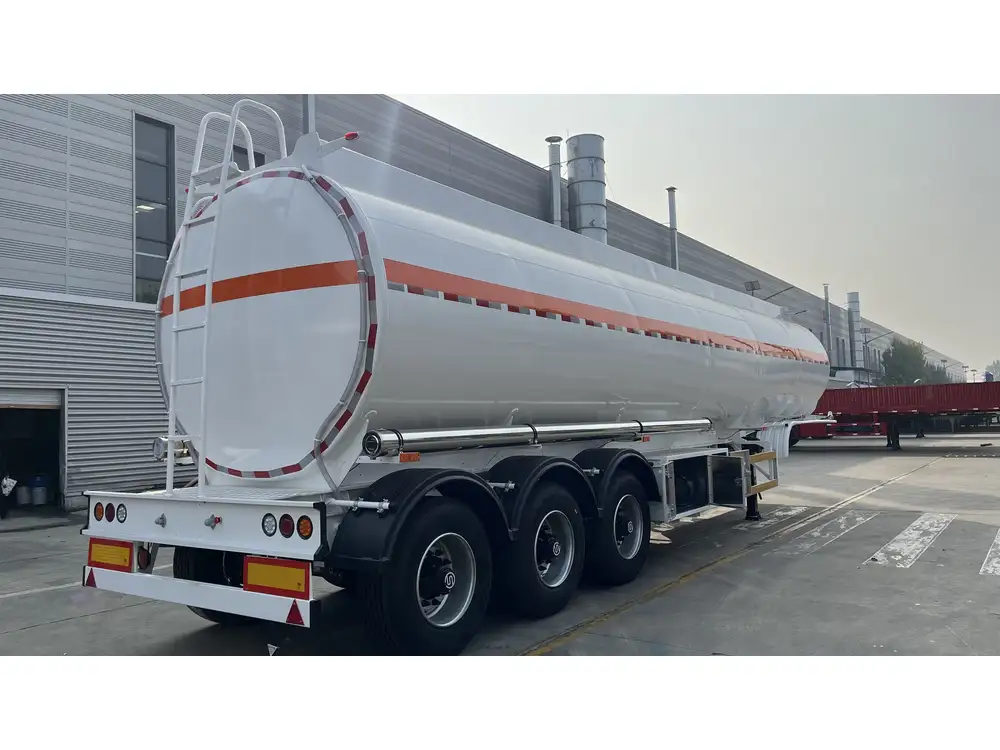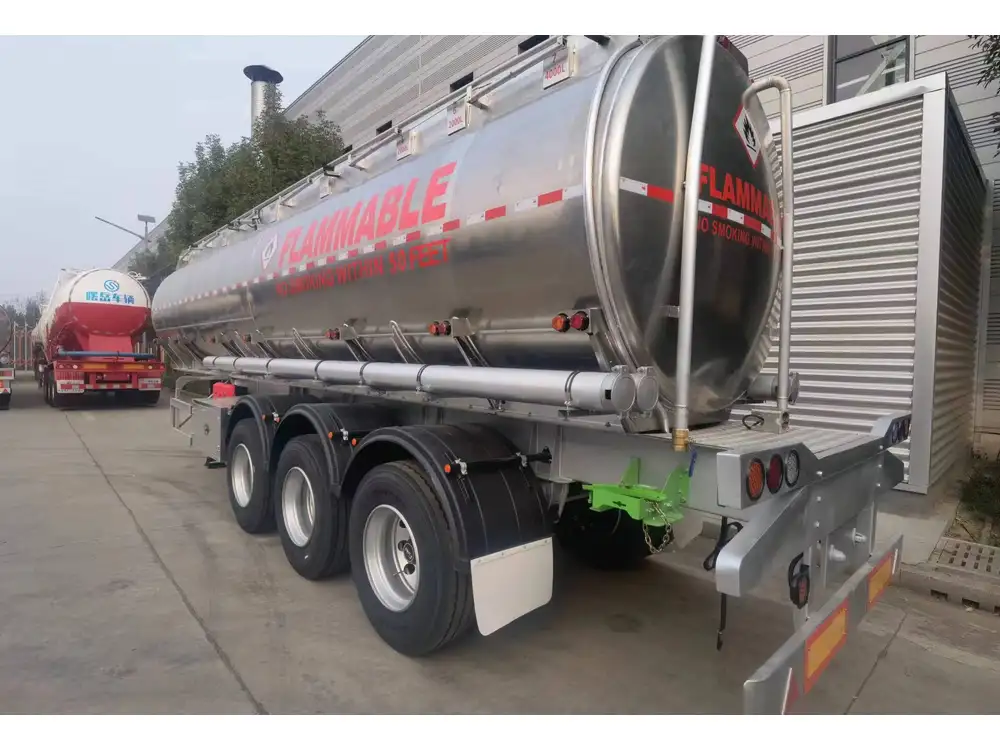When delving into the realm of specialized transport solutions, one cannot overlook the significance of non-code tanker trailers. These vehicles are meticulously engineered for transporting liquids that do not necessitate adherence to stringent regulatory codes. This article endeavors to dissect the intricacies of non-code tanker trailers, exploring their specifications, applications, benefits, and essential maintenance practices.
What is a Non-Code Tanker Trailer?
A non-code tanker trailer is a type of tank trailer designed to transport liquids exempt from the stringent regulations established for “code” tankers. Code tankers, such as those adhering to the specifications set forth by the American Society of Mechanical Engineers (ASME) or the Department of Transportation (DOT), are required for transporting hazardous materials and liquids under high pressure. In contrast, non-code tankers are utilized primarily for moving substances that are either non-hazardous or do not pose a significant risk during transport.
Key Characteristics of Non-Code Tanker Trailers
Construction Material
Non-code tanker trailers are typically constructed from materials like aluminum, carbon steel, or stainless steel, depending on the liquid being transported. Each material presents unique benefits, such as weight reduction or corrosion resistance.Design and Structure
These trailers feature a cylindrical shape to facilitate optimal pressure distribution and stability during transport. The design often includes baffles to minimize slosh, enhancing safety and control.Capacity
Non-code tanker trailers come in various sizes, generally ranging from 3,000 to 7,000 gallons. Their capacities can be tailored to suit specific transport needs, providing flexibility for manufacturers and distributors.Tank Configuration
The tank’s internal configuration impacts the ease of loading and unloading, as well as the movement of the liquid inside. Non-code trailers may have multiple compartments, allowing for the transport of different liquids simultaneously.Accessories and Safety Features
Important features often include hydraulic surge brakes, optimized loading and unloading systems, and protective body coating to prevent corrosion.

Common Applications of Non-Code Tanker Trailers
Non-code tanker trailers serve a variety of industrial and commercial purposes. Here are some prevalent applications:
| Application | Description |
|---|---|
| Food and Beverage Transport | Suitable for transporting non-hazardous food liquids, such as juices, oils, and syrups. |
| Agricultural Chemicals | Used for transporting fertilizers, weed killers, and seed treatments that don’t require stringent codes. |
| Water Transport | Ideal for hauling water for construction sites, irrigation, and municipal needs. |
| Industrial Chemicals | Capable of moving chemicals that are not classified as hazardous, such as certain cleaning agents. |
| Non-Hazardous Waste | Employed in the transport of waste materials that do not pose immediate health risks. |
Advantages of Using Non-Code Tanker Trailers
Utilizing non-code tanker trailers can yield numerous advantages for businesses and logistics providers:
Cost-Effectiveness
Since non-code trailers do not require complex safety compliance measures, their initial purchase and ongoing maintenance expenses are generally lower compared to code trailers.Versatility
Their adaptability allows non-code tankers to transport a wide range of liquids across various industries, increasing operational efficiency.Simplified Regulations
Given the lack of stringent regulatory requirements, companies can benefit from less bureaucratic red tape and quicker turnaround times in logistics.Lightweight Design
With the use of lighter materials, non-code trailers contribute to fuel efficiency, potentially lowering overall transportation costs.Easy Maintenance
The simpler construction and lack of intricate safety systems make non-code trailers easier to maintain and repair, enhancing vehicle uptime.
Maintenance Practices for Non-Code Tanker Trailers
Ensuring the longevity and safety of a non-code tanker trailer involves adhering to a comprehensive maintenance regimen. Here are critical practices that should be implemented:
Regular Inspections
Routine inspections of the tank and trailer components are essential to identify wear and potential issues before they worsen. Checking for leaks, corrosion, and structural integrity is paramount.Cleaning Protocols
Depending on the type of liquid transported, thorough cleaning after each haul is necessary to prevent contamination and ensure the integrity of the next load.Brake System Checks
Hydraulic and air brake systems should be inspected regularly to maintain optimal performance and safety standards.Tire Maintenance
Regular tire pressure checks and rotation can prevent blowouts and extend tire life. Properly inflated tires also assist in maintaining fuel efficiency.Documentation and Compliance
Keeping detailed records of maintenance procedures, inspections, and any repairs performed assists in complying with industry standards and becomes invaluable for resale purposes.

Challenges Faced by Non-Code Tanker Trailer Users
While non-code tanker trailers offer several benefits, users may encounter challenges that require proactive solutions:
Liquid Specificity
Different liquids necessitate distinct handling and transport protocols. Users must be aware of the specific characteristics and requirements of each liquid they handle.Potential Contamination
Although suitable for non-hazardous substances, if the trailer is improperly cleaned, there’s a risk of cross-contamination between loads.Market Fluctuations
The demand for non-code tanker trailers can be influenced by market changes in the chemical and agricultural sectors. Users must adapt to fluctuations in demand that may require scaling operations up or down.Regulatory Changes
While non-code tankers have fewer regulations compared to code trailers, changes in industry standards or local regulations could impact operations. Keeping abreast of any updates is crucial for compliance.Load Stability
The design of a non-code tanker trailer may contribute to liquid slosh during transit, particularly with partially loaded tanks. Incorporating baffles within the trailer can help mitigate this issue but may not eliminate it entirely.
Conclusion: Selecting the Right Non-Code Tanker Trailer
When choosing a non-code tanker trailer, it is vital to assess factors such as the specific types of liquids to be transported, the intended load capacities, and the operational requirements. The following checklist can assist businesses in making informed purchasing decisions:
| Selection Criteria | Consideration |
|---|---|
| Material | Choose based on the liquid’s properties and potential corrosiveness. |
| Size & Capacity | Ensure compatibility with the intended volume and weight requirements. |
| Structural Design | Evaluate load stability and slosh characteristics. |
| Brand and Manufacturer | Research the reputation and service quality of the manufacturer. |
| Cost of Ownership | Factor in purchase price, maintenance costs, and financing options. |
By thoroughly understanding the attributes, advantages, and maintenance requirements of non-code tanker trailers, businesses can make informed decisions that enhance their logistical efficacy while also adhering to safety and compliance standards. Ultimately, the right choice will lead to operational efficiencies, cost savings, and heightened reliability in transporting various liquids across diverse industries.



